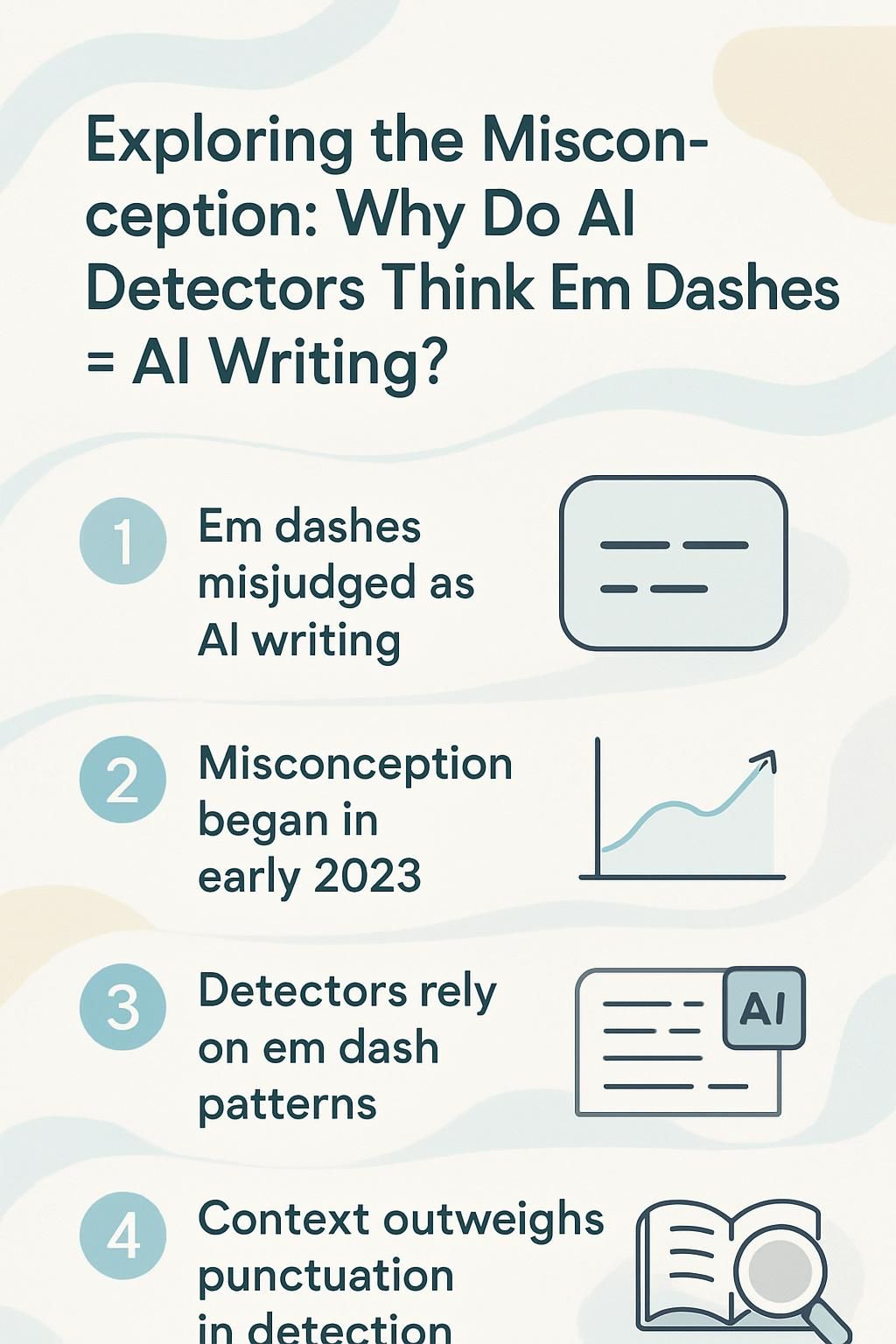Ever wondered why AI detectors think em dashes = AI writing? Some people believe using too many em dashes means a text was written by a machine. This blog will unpack that misconception and explain why this idea is misleading.
Keep reading to learn the truth about em dashes in writing!
Key Takeaways
- Em dashes are often misjudged as marks of AI writing, but both human and AI writers use them for style and clarity.
- The misconception started in early 2023 through social media claims and platforms like Reddit, despite no solid evidence.
- AI detectors rely on patterns like frequent em dash use in older models, leading to false assumptions about authorship.
- Human writers such as Emily Dickinson used em dashes heavily, showing they aren’t unique to machine-generated text.
- Context matters more than punctuation patterns when distinguishing between human and AI-written content.

The Misconception: Em Dashes as AI Writing Indicators
Some folks think em dashes are a sign of AI-generated writing. This idea started spreading online in early 2023. Social media users linked frequent use of these long dashes to tools like ChatGPT.
A LinkedIn user even called them “weird long dashes” and claimed to see them everywhere in posts, though they offered no proof.
A strange case on Reddit fueled the debate further. One person suspected their coworker’s emails were from an AI because of repeated em dash usage. The _LuxeGen_ podcast later labeled it the “ChatGPT hyphen,” criticizing its appearance in ads by certain brands.
Despite all this chatter, there’s no hard evidence that heavy use of em dashes points solely to AI writing styles or patterns.
Why Em Dashes Are Common in Writing
Em dashes add flair and rhythm to sentences, breaking up thoughts or adding emphasis. Writers use them to make text more lively and engaging.
Usage in Creative Writing and Journalism
Creative writers use em dashes to add emotion and flow. They create breaks that feel natural, much like pauses in speech. Emily Dickinson used them often for her poetic style, giving her work a unique rhythm.
Friedrich Nietzsche leaned on them too, shaping his philosophical ideas with clarity.
In journalism, em dashes help explain or highlight certain points without extra clutter. Magazines and newspapers from the 1970s adopted this practice to make stories more engaging.
Bryan Garner even called it “the most underused punctuation mark” in American writing. This history influences how AI models handle language today, mimicking these patterns seen across decades of human texts.
The dash is a handy tool for those who have learned how to use it effectively. – Bryan Garner
Em Dashes as a Stylistic Choice
Many writers love em dashes for their flexibility and style. Moniza Hossain joked about them being her “emotional support punctuation mark.” They often replace commas, colons, or parentheses to create a specific rhythm.
Aileen Gallagher called them powerful tools in writing. Em dashes can mimic natural speech, adding flow to text.
J.T. Bushnell praised their elegance and conversational tone. Fiction writer Rebecca Crunden disliked seeing them tied unfairly to AI writing claims. These marks hold value beyond trends; they help convey emotion and voice clearly without overloading sentences with extra words or brackets.
Understanding AI Detectors and Their Limitations
AI detectors rely on spotting patterns, but these tools sometimes stumble. They can mistake common writing habits for signs of AI.
How AI Detectors Analyze Patterns
AI detectors study patterns in text. They scan for repeated trends in punctuation, word choice, and sentence structure. For example, pre-2023 AI models often mimicked formal writing by using more em dashes or stiff language.
Detectors flag such habits because they stand out from human style.
These systems rely on statistics to compare texts. If a tool notices high use of words like “delve,” it might assume the content comes from AI. This overreliance on number-crunching creates mistakes and false positives.
Algorithms see numbers where we see meaning.
Overreliance on Statistical Assumptions
AI writing detectors often rely on patterns in data, not true understanding. They use statistical assumptions to guess if text is AI-generated. This can lead to mistakes. For example, polished writing or frequent punctuation like an em dash might trigger false positives.
Many believe flawless text must be from machines, but human writers and editors also create clean content without errors.
This method creates bias when judging creative styles. Human trends in grammar or word choice get flagged unfairly because tools over-prioritize numbers instead of meaning. Misjudging writing limits its value and spreads misconceptions about what makes a piece feel original or machine-like.
Moving forward, how detectors analyze patterns impacts why they mistake em dashes for AI traits.
Why Em Dashes Are Misidentified
AI detectors sometimes confuse em dashes with machine-made writing. This happens because they spot patterns, but not context or intent.
Frequency in AI-Generated Texts vs. Human Writing
Some people assume em dashes are a hallmark of AI writing. Let’s look at how often they appear in AI-generated versus human-created texts.
Here’s a simple breakdown comparing the two:
| Aspect | AI-Generated Texts | Human Writing |
|---|---|---|
| Punctuation Preferences | Favors em dashes more often. ChatGPT adjusts usage based on prompts. | Mixed use of punctuation, depending on style and context. |
| Frequency of Em Dashes | Em dashes appear repeatedly, especially in AI trying to mimic formal or creative tones. | Em dashes appear less frequently compared to commas or semicolons. |
| Stylistic Flexibility | Often standardizes em dash usage when tasked with writing in a formal tone. | Writers use a particular style based on expressive needs rather than fixed patterns. |
| Language Rules | AI models may overuse em dashes to emphasize connections between ideas. | More natural punctuation variety, sometimes breaking rules creatively. |
AI writing leans on em dashes to connect thoughts. They often appear in creative or formal AI outputs. Human writers, on the other hand, sprinkle em dashes sparingly, relying instead on commas, periods, or other punctuation.
Patterns vary across different contexts. ChatGPT, for instance, uses em dashes more if prompted to write formally. But, this is a behavior pattern, not proof of AI authorship.
Both AI and human styles adapt. But AI tools, like older models, tended to overuse em dashes as part of mimicking polished text. Em dash frequency alone isn’t enough to label writing as AI-generated.
Misinterpretation of Punctuation Trends
AI detectors sometimes treat punctuation like a code to spot bots. They often flag em dashes as signs of AI writing. This bias may come from the increased use of such punctuation in machine-generated texts.
Yet, it overlooks how human writers also rely on these marks for clarity and style.
Public literacy about certain punctuation has waned over time too. For instance, the em dash was once celebrated in works by Emily Dickinson and others. Now, its misuse or overuse can lead to false assumptions about authorship.
Writers like Hossain even joke that AI “stole” their freedom to use this mark without being judged unfairly!
Debunking the Myth: Em Dashes Are Not an AI Fingerprint
Em dashes are just tools, like commas or periods—they belong to everyone. AI detectors may overthink their use, but punctuation doesn’t have a secret code.
Are Em Dashes a Sign of AI-Generated Text?
Em dashes have wrongly earned a reputation as an AI giveaway. Some older models used this punctuation heavily, creating the misconception. ChatGPT has clarified that em dashes aren’t reliable indicators of AI writing.
AI detectors often rely on patterns and statistics, not context or style. Em dashes appear in both human and AI writing styles. Writers like Emily Dickinson famously used them constantly in poetry.
Teachers might suspect AI text due to formulaic structures or flat tone instead, not just punctuation choices like this one.
Conclusion
AI detectors often oversimplify writing patterns, leading to unfair assumptions about punctuation like the em dash. These tools rely on math and trends, not deep understanding. Human and AI writing can share quirks, but context matters more than any single mark on a page.
So, let your style shine without fear of being mislabeled by algorithms chasing shadows. Writing is about meaning, not machines drawing lines where none exist!
For further reading on this topic, check out our detailed article: Are Em Dashes Truly a Sign of AI-Generated Text?




